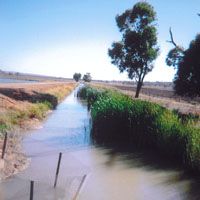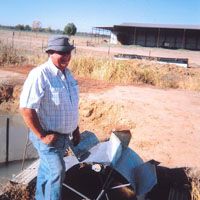John Oxley (c. 1785-1828) was among the first Europeans to ever explore this flat, brown and red land, after he was appointed surveyor-general of the British colony of New South Wales in 1817.
Back then, the Royal Navy officer called it "a howling wilderness of barren isolation." He wrote in his diary that he was the first white man to see it, and would "undoubtedly" be the last to behold this vast expanse that had, for 40,000 years, been the home of the Wiradjuri people, who relied on the Murrumbidgee River to sustain their hard but free life.
Oxley was wrong. Many Europeans came to Australia and challenged the wilderness. They brought Chinese workers with them, experts in cutting down the tough thorny scrub, ring-barking trees, sinking wells and making vegetable gardens. These white "squatters" also brought sheep, cattle and horses.
In 1861, a Land Act allowed any white man to "select" 40 to 320 acres [1.6 to 130 hectares] of any Crown land, and to buy it from the government at a fixed price of one pound sterling an acre. They paid a 5-shilling (quarter-pound) deposit on application, and had three years to settle the balance, with no interest.
Despite the dearth of rain in the region, there were tough tall trees such as the native cypress pines, whose roots could get deep enough to reach water, and whose wood could be turned into good timber.
But then, in 1902, men of vision came up with a grand scheme for irrigation. The so-called Barren Jack and Murrumbidgee canals were dug, with hand tools and horse power. This work was carried out in temperatures that could soar to 45 C. Dams were built to contain runoff from the Great Dividing Range that runs inland along the eastern side of Australia from Queensland in the north to southerly Victoria. That runoff was then brought to this thirsty place through 4,000 km of canals and irrigation channels criss-crossing the vast expanse of 480,000 hectares of land.
In 1916 the railway came, and by now there were many immigrants from Italy. Vineyards and groves of olives and citrus were laid out.
The first man known to have planted grape-vine cuttings in the area, in 1913, was a certain J.J. McWilliams. He is famous for saying, "Plant a 3-inch nail in this soil, water it, and in a year you'll have a crowbar." He planted 40,000 cuttings, watered them from horse-drawn tanks, and in 1915 got his first vintage of 20 tons of wine.
Even with the sparse rains, irrigation in this area southwest of Sydney to north of Melbourne — now known as the Riverina and Murrumbidgee Irrigation Area of New South Wales — allowed it to become the breadbasket of Australia, and later also to become hugely productive in rice.
Water was always precious there, and it was metered out to individual farms by a waterwheel invented by John Dethridge, who was the commissioner to the New South Wales State Rivers and Water Supply from 1911 to 1926. Some of these wheels are still in use today, but are being replaced by more modern monitoring devices, now controlled by a central computer system and inspectors who travel the waterways on a daily basis.
The area became known for highly productive, diversified farms of 150 to 400 hectares, growing rice, maize, soybeans, wheat, barley, rape (for canola oil), beans and other legumes, with pastures for sheep and cattle. They also grew potatoes, sweet corn, carrots, pumpkins, onions, tomatoes, melons and more.
There were smaller horticultural farms, too, traditionally less than 20 hectares before they amalgamated with others, growing crops such as grapes, oranges, lemons, grapefruit, mandarins, peaches and plums. They also relied on a guaranteed supply of irrigation water.
Then came the huge "dry area farms" of 1,500 to 6,000 hectares, which conserved water as much as humanly possible with a crop rotation system, growing wheat, barley and oats followed by rape and pulses — then lying fallow but used as pasture.
I've written this very simply, because the area is wonderfully diversified in crops and water-usage systems, and I can't do their huge efforts justice in such a short space. Farmers made their own ponds, water tanks and small dams to hold water. They are very, very water-conscious!
I went there in March as part of an NHK documentary program on the effects of climate change, because many smaller farmers are now going out of business for lack of rain to grow their crops or feed their cattle.
When I arrived, I thought the countryside looked deceptively green in patches, because the vines and fruit trees receive irrigation water fed directly to their root systems. Wheat fields and rice paddies, however, were as dry as a bone, with whirling dust devils spinning over the reddish-brown earth and taking columns of dust into the air for hundreds of meters.
Meanwhile, I found that the reservoirs were running low and river levels were going down and down in steps. All the farmers we met and talked to were sincerely hoping — if not praying — for rain by the end of April.
We met one man whose family had farmed wheat, sheep and cattle just outside the small town of Griffith (some 600 km west of Sydney) for 80 years. He saw things through for four years with no income at all, then finally had to sell his land to survive. He sold it to a man who wants to raise grain for his huge chicken farms and who can, for the time being anyway, gamble on getting some rain. We met other farmers who forked out the money to buy feed and water for dairy cattle for seven years before finally going broke and being forced to give up.
Some Australians just shrugged and said that their land has always gone through droughts, and this was just another one. Rural Australians on the whole seemed to be a cheerful, tough, optimistic lot. But others, including scientists, were sure that the drought would not just go away — and that it is part of global climate change. Either way, we saw figures to indicate a 40 percent loss in grain production in the last few years.
This desperate situation, combined with a growing market for grains and pulses to feed China and India, not to mention an extremely dependent Japan, is surely a warning for all of us to stop wasting, stop polluting — and in Japan especially, to try to be more self-sufficient.
I have met economic experts who say that self-sufficiency for Japan is nonsense, that this country must always import. I question the totality of that.
My neighbor has been feeding his dairy cows for the past decade on imported grain, and he has not bothered to cut his hay fields. Those fields are now becoming a jungle of dense pigweed that threatens to overrun my little garden. Around where I live in the Nagano hills, I see about a quarter of the paddies now growing nothing more than useless weeds. I also see fewer and fewer young people working the land (although they still line up at 10 in the morning to file into the huge brand-new pachinko parlor!).
In my view, even a small country like Japan needs all its rice paddies, fields, orchards and pastures for environmental health and education reasons, even if homegrown rice, wheat or soybeans cannot compete in prices with imports. Climate change is going to bring about a dearth of food, and huge increases in food prices, which will inevitably make the poor and disadvantaged suffer most.
On my small patch, we grow all the vegetables we can, not to mention cultivating wild mountain vegetables and mushrooms from our woods. We also encourage our local small-farmer friends who grow rice organically by buying their produce, even if it is more expensive.
The crunch is bound to come, and I'd rather try to fight it on living land rather than on hot, dead tarmac and concrete.






















With your current subscription plan you can comment on stories. However, before writing your first comment, please create a display name in the Profile section of your subscriber account page.